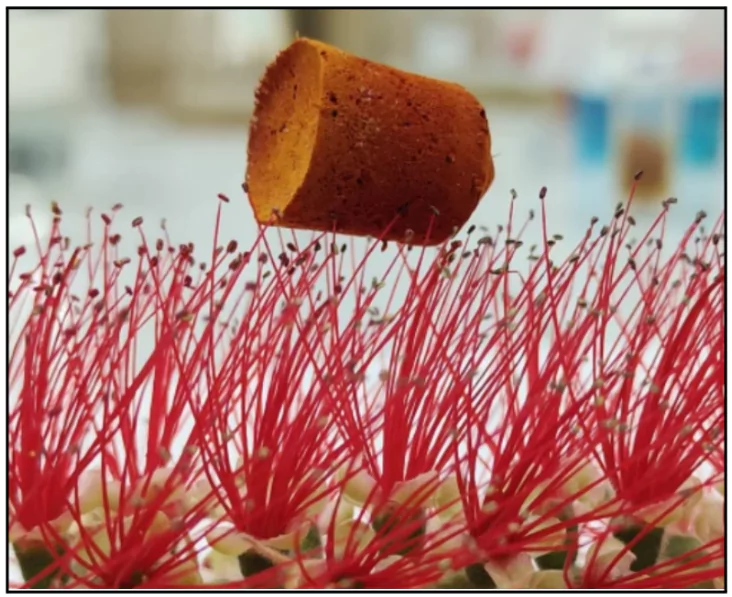Researchers from Indian Institute of Science Education and Research (IISER) Pune, developed a hybrid aerogel IPcomp-9 capable of efficiently extracting gold from electronic waste.

About the Hybrid Aerogel IPcomp-9
- IPcomp-9 is a novel hybrid aerogel with tailored active sites that can selectively capture gold ions from electronic waste (e-waste) and contaminated water.
- Researchers at IISER synthesised IPcomp-9 by covalently linking two types of crystalline solid materials, a metal-organic polyhedral made up of zirconium and a 2D imine-linked covalent organic framework.
- The researchers used iron nitrate salt to thread the two materials together at room temperature within two to five minutes.
Enroll now for UPSC Online Classes
About E- waste
- E-waste refers to discarded electronic and electrical equipment, including devices like gadgets, computers, and household appliances.
- Components of E-Waste:
-
- Metals: Gold, silver, copper, platinum, aluminum, and palladium.
- Plastics: Used in casings and insulation.
- Glass: Found in screens and monitors.
- Hazardous Substances: Lead, mercury, cadmium, and flame retardants.
- Other Materials: Batteries, circuit boards, and small mechanical parts.
Rising E-Waste in India:
- India contributes 6.4% of global e-waste.
- E-waste generation in India grew by 131% between 2020 and 2022, as reported by the UN Trade and Development.
- Global E-Waste Monitor 2020 predicts India’s e-waste to increase from 9.2 million tons to 74.7 million tons by 2030.
|
- Mechanism of Absorption: The imine groups and the positively charged zirconium clusters are the key parts that attract and bind negatively charged gold ions.
- The attached ions are then rapidly converted into metallic gold.
- Efficiency: They extracted up to 99% of gold ions from e-waste and achieved 1689 mg/g extraction under daylight and 2349 mg/g under blue light.
- Dual Process: The aerogel facilitates adsorption and reduction, yielding reasonably pure gold and minimizing the need for further purification.
- Potential Applications: If scaled up, this technique could revolutionize e-waste management and promote sustainable resource recovery.
- Diversified application: It can also extract ultra-trace amounts of gold from rivers, lakes, groundwater, and seawater.
- Reusibility: It can be reused up to five times and effectively extracts gold from e-waste solutions, avoiding toxic chemicals.
- Economic and Environmental Benefits: The technique offers a sustainable method to manage e-waste and reduce dependence on hazardous mining practices, turning waste into wealth.
- Traditional gold extraction methods, such as pyrometallurgy, hydrometallurgy , and cyanide extraction, are energy-intensive, time-consuming, complex and costly.
- They also release harmful chemicals that damage the environment.
Check Out UPSC NCERT Textbooks From PW Store
What are Aerogels?
- Aerogels are a class of ultralight materials with extremely low density and high porosity.
- They are derived from gels where the liquid component is replaced with a gas without significant structural collapse.
- The solid component in silica aerogel consists of tiny, three-dimensional, intertwined clusters which comprise only 3% of the volume and air in microscopic pores make up the remaining 97% of aerogel’s volume making it a very poor conductor.
- This air has very little room to move, inhibiting both convection and gas-phase conduction. These characteristics make aerogel the world’s lowest density solid and most effective thermal insulator
Types of Aerogels
- Silica Aerogel: Most common type, derived from silica.
- Carbon Aerogel: Made from organic precursors, known for high electrical conductivity.
- Metal Oxide Aerogels: Derived from metal oxides like alumina and iron oxide.
- Polymer Aerogels: Based on organic polymers, offering flexibility and tunable properties.
- Hybrid Aerogels: These are composite materials that combine two or more different types of materials within their structure.
Applications of Aerogels
- Thermal Insulation: Excellent insulators due to their high porosity and low thermal conductivity. Used in space exploration, cryogenics, and building materials.
- Catalysis: High surface area provides active sites for chemical reactions, making them useful as catalysts.
- Sound Absorption: Effective sound absorbers due to their porous structure. Used in acoustic panels and noise reduction.
- Sensors: Sensitive to changes in temperature, pressure, and humidity, making them suitable for sensor applications.
- Drug Delivery: Can be used as carriers for drug delivery due to their high surface area and biocompatibility.
- Aerospace: Used in spacecraft components due to their lightweight and high strength-to-weight ratio.
|
Additional Reading: e- waste Recycling
![]() 24 Dec 2024
24 Dec 2024

